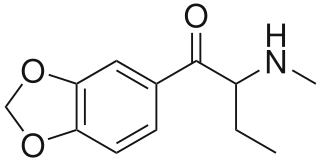
Methcathinone is a monoamine alkaloid and psychoactive stimulant, a substituted cathinone. It is used as a recreational drug due to its potent stimulant and euphoric effects and is considered to be addictive, with both physical and psychological withdrawal occurring if its use is discontinued after prolonged or high-dosage administration. It is usually snorted, but can be smoked, injected, or taken orally.

Cathinone is a monoamine alkaloid found in the shrub Catha edulis (khat) and is chemically similar to ephedrine, cathine, methcathinone and other amphetamines. It is probably the main contributor to the stimulant effect of Catha edulis, also known as khat. Cathinone differs from many other amphetamines in that it has a ketone functional group. Other phenethylamines that share this structure include the stimulants methcathinone, MDPV, mephedrone and the antidepressant bupropion.

Butylone, also known as β-keto-N-methylbenzodioxolylbutanamine (βk-MBDB), is an entactogen, psychedelic, and stimulant psychoactive drug of the phenethylamine chemical class. It is the β-keto analogue of MBDB and the substituted methylenedioxyphenethylamine analogue of buphedrone.

Methylone, also known as 3,4-methylenedioxy-N-methylcathinone (MDMC), is an empathogen and stimulant psychoactive drug. It is a member of the amphetamine, cathinone and methylenedioxyphenethylamine classes.

Methylenedioxypyrovalerone (MDPV) is a stimulant of the cathinone class that acts as a norepinephrine–dopamine reuptake inhibitor (NDRI). It was first developed in the 1960s by a team at Boehringer Ingelheim. Its activity at the dopamine transporter is six times stronger than at the norepinephrine transporter and it is virtually inactive at the serotonin transporter. MDPV remained an obscure stimulant until around 2004 when it was reportedly sold as a designer drug. In the US, products containing MDPV and labeled as bath salts were sold as recreational drugs in gas stations, similar to the marketing for Spice and K2 as incense, until it was banned in 2011.

α-Pyrrolidinopropiophenone (α-PPP), is a stimulant drug. It is similar in structure to the appetite suppressant diethylpropion and has analogous effects in animals. Little is known about this compound, but it has been detected by laboratories in Germany as an ingredient in "ecstasy" tablets seized by law enforcement authorities. This drug has been found to produce stimulant effects in animals and presumably also produces these effects in humans, based on the context in which it has been found.

Methedrone is a recreational drug of the cathinone chemical class. Chemically, methedrone is closely related to para-methoxymethamphetamine (PMMA), methylone and mephedrone. Methedrone received media attention in 2009 after the death of two young Swedish men. In both cases toxicology analysis showed methedrone was the only drug present in both men during the time of their overdose and subsequent deaths.

Mephedrone, also known as 4-methylmethcathinone, 4-MMC, and 4-methylephedrone, is a synthetic stimulant drug of the amphetamine and cathinone classes. Slang names include drone, M-CAT, White Magic, meow meow and bubble. It is chemically similar to the cathinone compounds found in the khat plant of eastern Africa. It comes in the form of tablets or crystals, which users can swallow, snort or inject, producing effects similar to those of MDMA, amphetamines and cocaine.

Phthalimidopropiophenone is a chemical intermediate used in the synthesis of cathinone. It has been found to be sold on the illicit market as a controlled substance analogue, but little is currently known about its pharmacology or toxicology.

4'-Methyl-α-pyrrolidinopropiophenone is a stimulant drug and substituted cathinone. It is structurally very similar to α-PPP, with only one added methyl group in the para position on the phenyl ring. 4-MePPP was sold in Germany as a designer drug in the late 1990s and early 2000s, along with a number of other pyrrolidinophenone derivatives. Although it has never achieved the same international popularity as its better-known relations α-PPP and MDPV, 4-MePPP is still sometimes found as an ingredient of grey-market "bath salt" blends such as "NRG-3".

α-Pyrrolidinopentiophenone is a synthetic stimulant of the cathinone class developed in the 1960s that has been sold as a designer drug. Colloquially, it is sometimes called flakka. α-PVP is chemically related to pyrovalerone and is the ketone analog of prolintane.

Substituted cathinones, which include some stimulants and entactogens, are derivatives of cathinone. They feature a phenethylamine core with an alkyl group attached to the alpha carbon, and a ketone group attached to the beta carbon, along with additional substitutions. Cathinone occurs naturally in the plant khat whose leaves are chewed as a recreational drug.

3-Fluoromethcathinone is a chemical compound of the phenethylamine, amphetamine, and cathinone classes that has been sold online as a designer drug. It is a structural isomer of flephedrone (4-fluoromethcathinone).

4-Methylethcathinone or 4-MEC is a chemical that bears a chemical resemblance to mephedrone. Due to its similarity to mephedrone, it is thought to be a stimulant and entactogen drug of the phenethylamine, amphetamine, and cathinone chemical classes. It has been marketed alone or in mixtures with other substituted cathinones under the name "NRG-2", although other blends such as "NRG-1" may have been more ambiguous with their ingredients.

Pentedrone is a stimulant of the cathinone class that has been sold as a designer drug and has been found since 2010 as an ingredient in a number of "bath salt" mixes sold as legal highs.
Bath salts are a group of recreational designer drugs. The name derives from instances in which the drugs were disguised as bath salts. The white powder, granules, or crystals often resemble Epsom salts, but differ chemically. The drugs' packaging often states "not for human consumption" in an attempt to circumvent drug prohibition laws. Additionally, they may be mislabeled as plant food, powdered cleaner, and other such products.

N-Ethylbuphedrone is a stimulant of the cathinone class that has been sold as a designer drug. It is the β-ketone analogue of N,alpha-diethylphenylethylamine.

3-Methylmethcathinone, also known as 3-MMC and metaphedrone, is a designer drug from the substituted cathinone family. 3-MMC is closely related in structure to the more commonly known illicit drug mephedrone (4-MMC), and is also illegal in most countries that have banned mephedrone due to 3-MMC being a structural isomer of 4-MMC. However, 3-MMC has still appeared on the recreational drug market as an alternative to mephedrone, and was first identified being sold in Sweden in 2012. Unlike some synthetic cathinones, 3-MMC has been evaluated in at least one large mammal study. 3-MMC is a monoamine transporter substrate that potently inhibits norepinephrine uptake and displays more pronounced dopaminergic vs. serotonergic activity.

5F-AMB (also known as 5F-MMB-PINACA and 5F-AMB-PINACA) is an indazole-based synthetic cannabinoid from the indazole-3-carboxamide family, which has been used as an active ingredient in synthetic cannabis products. It was first identified in Japan in early 2014. Although only very little pharmacological information about 5F-AMB itself exists, its 4-cyanobutyl analogue (instead of 5-fluoropentyl) has been reported to be a potent agonist for the CB1 receptor (KI = 0.7 nM).

Dimethylone (βk-MDDMA) is a substituted cathinone derivative with stimulant and empathogenic effects. Unlike the corresponding amphetamine derivative MDDM which is thought to be practically inactive, dimethylone substitutes for methamphetamine and MDMA in animal studies and has been sold as a designer drug.


















